Tweco 50XL User Manual
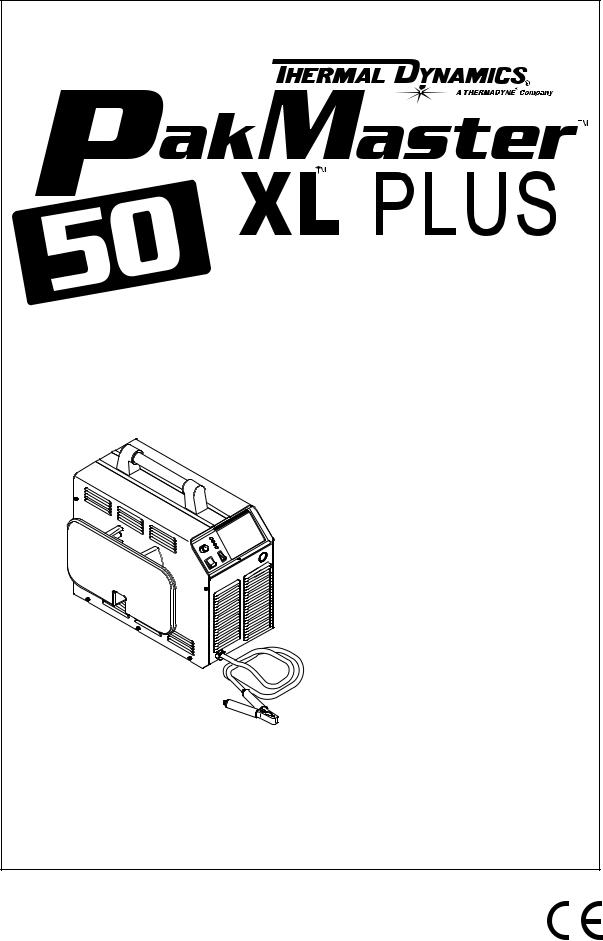
|
Air Plasma Cutting |
|
Power Supply (CE) |
|
A-02464 |
Operating Manual |
|
July 30, 1999 |
Manual No. 0-2780 |
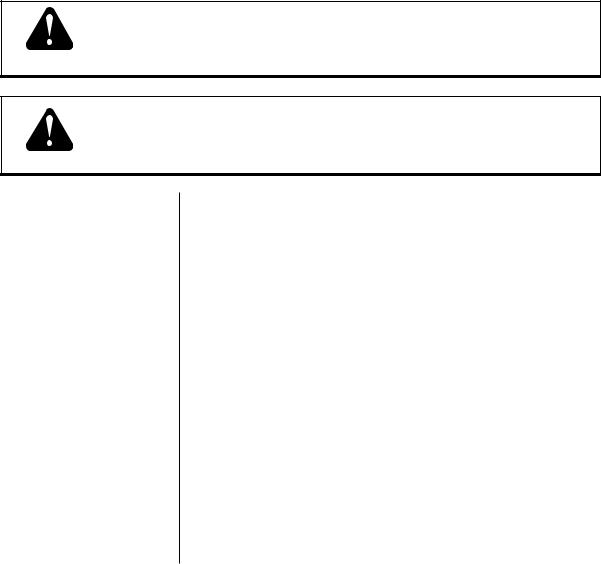
Read and understand this entire manual and your employer’s WARNING safety practices before installing, operating, or
servicing the equipment.
While the information contained in this manual represents our WARNING best judgement, Thermal Dynamics Corporation assumes no
liability for its use.
Pak Master® 50XL PLUS Air Plasma Cutting Power Supply Operating Manual (CE) Number 0-2780
Published by:
Thermal Dynamics Corporation Industrial Park No. 2
West Lebanon, New Hampshire, USA 03784 (603) 298-5711
Copyright 1999 by
Thermal Dynamics Corporation
All rights reserved.
Reproduction of this work, in whole or in part, without written permission of the publisher is prohibited.
The publisher does not assume and hereby disclaims any liability to any party for any loss or damage caused by any error or omission in the Pak Master® 50XL PLUS Air Plasma Cutting Power Supply Operating Manual (CE), whether such error results from negligence, accident, or any other cause.
Printed in the United States of America
July 1999
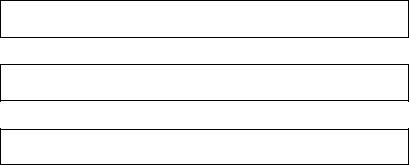
Record Serial Numbers For Warranty Purposes
Purchase Date
Power Supply
Torch
|
TABLE OF CONTENTS |
|
SECTION 1: |
|
|
GENERAL INFORMATION ................................................................................................... |
1 |
|
1.01 |
Notes, Cautions and Warnings ........................................................................ |
1 |
1.02 |
Important Safety Precautions ........................................................................ |
1 |
1.03 |
Publications ................................................................................................... |
2 |
1.04 |
Note, Attention et Avertissement ................................................................... |
3 |
1.05 |
Precautions De Securite Importantes............................................................. |
3 |
1.06 |
Documents De Reference .............................................................................. |
5 |
1.07 |
Declaration of Conformity ............................................................................... |
7 |
1.08 |
Statement of Warranty .................................................................................... |
8 |
SECTION 2: |
|
|
INTRODUCTION .................................................................................................................. |
9 |
|
2.01 |
Scope of Manual ............................................................................................ |
9 |
2.02 |
General Description of System ...................................................................... |
9 |
2.03 |
Specifications/Design Features ...................................................................... |
9 |
2.04 |
Power Supply Options and Accessories ........................................................ |
10 |
SECTION 3: |
|
|
INSTALLATION PROCEDURES .......................................................................................... |
11 |
|
3.01 |
Introduction ................................................................................................... |
11 |
3.02 |
Site Selection ............................................................................................... |
11 |
3.03 |
Unpacking ..................................................................................................... |
11 |
3.04 |
Lifting Options ............................................................................................... |
11 |
3.05 |
Input Power Connections ............................................................................... |
12 |
3.06 |
Input Voltage Selection.................................................................................. |
12 |
3.07 |
Primary Input Power Cable Connections ........................................................ |
13 |
3.08 |
Gas Connections .......................................................................................... |
14 |
3.09 |
Connecting Torch Leads ................................................................................ |
16 |
3.10 Work Cable And Ground Connections............................................................ |
16 |
|
SECTION 4: |
|
|
OPERATION........................................................................................................................ |
|
19 |
4.01 |
Introduction ................................................................................................... |
19 |
4.02 |
Functional Overview...................................................................................... |
19 |
4.03 |
Operating Controls ........................................................................................ |
19 |
4.04 |
Sequence of Operation.................................................................................. |
21 |
4.05 |
Preparations for Operating ............................................................................ |
22 |
4.06 |
Cut Quality .................................................................................................... |
23 |
SECTION 5: |
|
|
CUSTOMER/OPERATOR SERVICE .................................................................................... |
25 |
|
5.01 |
Introduction ................................................................................................... |
25 |
5.02 |
General Maintenance .................................................................................... |
25 |
5.03 |
Common Operating Problems ....................................................................... |
26 |
5.04 Troubleshooting Guide ................................................................................... |
27 |
|
5.05 |
Power Supply Parts Replacement ................................................................. |
29 |
|
TABLE OF CONTENTS (continued) |
|
SECTION 6: |
|
|
PARTS LISTS ..................................................................................................................... |
31 |
|
6.01 |
Introduction ................................................................................................... |
31 |
6.02 |
Ordering Information...................................................................................... |
31 |
6.03 |
Complete Power Supply Replacement ........................................................... |
32 |
6.04 |
Replacement Parts ....................................................................................... |
32 |
6.05 |
Options and Accessories .............................................................................. |
32 |
APPENDIX I: INPUT WIRING REQUIREMENTS ........................................................................ |
33 |
|
APPENDIX II: SEQUENCE OF OPERATION (BLOCK DIAGRAM) ............................................. |
34 |
|
APPENDIX III: SYSTEM SCHEMATIC ....................................................................................... |
36 |
|
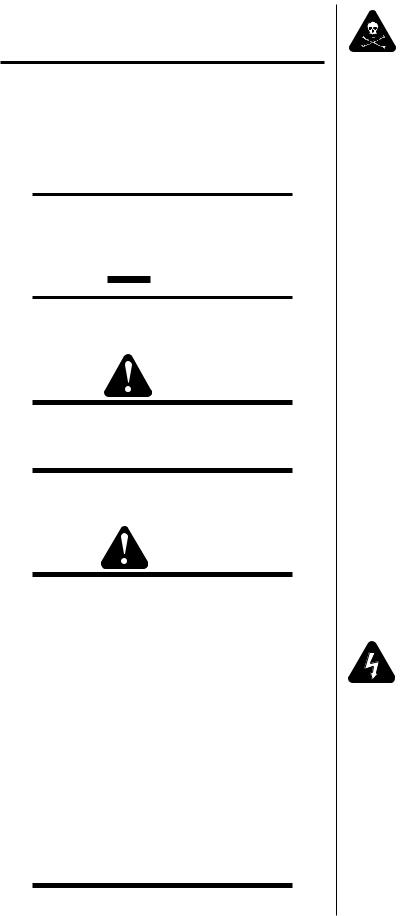
SECTION 1:
GENERAL INFORMATION
1.01 Notes, Cautions and Warnings
Throughout this manual, notes, cautions, and warnings are used to highlight important information. These highlights are categorized as follows:
NOTE
An operation, procedure, or background information which requires additional emphasis or is helpful in efficient operation of the system.
CAUTION
A procedure which, if not properly followed, may cause damage to the equipment.
WARNING
A procedure which, if not properly followed, may cause injury to the operator or others in the operating area.
1.02 Important Safety Precautions
WARNINGS
OPERATION AND MAINTENANCE OF PLASMA ARC EQUIPMENT CAN BE DANGEROUS AND HAZARDOUS TO YOUR HEALTH.
Plasma arc cutting produces intense electric and magnetic emissions that may interfere with the proper function of cardiac pacemakers, hearing aids, or other electronic health equipment. Persons who work near plasma arc cutting applications should consult their medical health professional and the manufacturer of the health equipment to determine whether a hazard exists.
To prevent possible injury, read, understand and follow all warnings, safety precautions and instructions before using the equipment. Call 1-603- 298-5711 or your local distributor if you have any questions.
GASES AND FUMES
Gases and fumes produced during the plasma cutting process can be dangerous and hazardous to your health.
•Keep all fumes and gases from the breathing area. Keep your head out of the welding fume plume.
•Use an air-supplied respirator if ventilation is not adequate to remove all fumes and gases.
•The kinds of fumes and gases from the plasma arc depend on the kind of metal being used, coatings on the metal, and the different processes. You must be very careful when cutting or welding any metals which may contain one or more of the following:
Antimony |
Chromium |
Mercury |
Arsenic |
Cobalt |
Nickel |
Barium |
Copper |
Selenium |
Beryllium |
Lead |
Silver |
Cadmium |
Manganese |
Vanadium |
•Always read the Material Safety Data Sheets (MSDS) that should be supplied with the material you are using. These MSDSs will give you the information regarding the kind and amount of fumes and gases that may be dangerous to your health.
•For information on how to test for fumes and gases in your workplace, refer to item 1 in Subsection 1.03, Publications in this manual.
•Use special equipment, such as water or down draft cutting tables, to capture fumes and gases.
•Do not use the plasma torch in an area where combustible or explosive gases or materials are located.
•Phosgene, a toxic gas, is generated from the vapors of chlorinated solvents and cleansers. Remove all sources of these vapors.
ELECTRIC SHOCK
Electric Shock can injure or kill. The plasma arc process uses and produces high voltage electrical energy. This electric energy can cause severe or fatal shock to the operator or others in the workplace.
•Never touch any parts that are electrically “live” or “hot.”
•Wear dry gloves and clothing. Insulate yourself from the work piece or other parts of the welding circuit.
•Repair or replace all worn or damaged parts.
•Extra care must be taken when the workplace is moist or damp.
Date: 6/22/99 |
1 |
GENERAL INFORMATION |
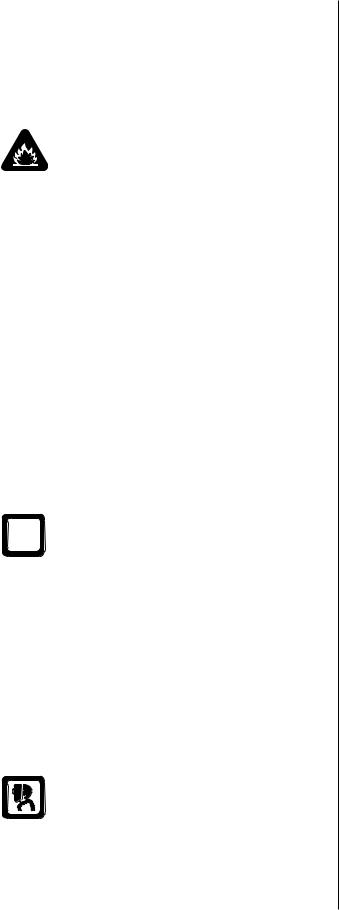
•Install and maintain equipment according to NEC code, refer to item 9 in Subsection 1.03, Publications.
•Disconnect power source before performing any service or repairs.
•Read and follow all the instructions in the Operating Manual.
FIRE AND EXPLOSION
Fire and explosion can be caused by hot slag, sparks, or the plasma arc.
•Be sure there is no combustible or flammable material in the workplace. Any material that cannot be removed must be protected.
•Ventilate all flammable or explosive vapors from the workplace.
•Do not cut or weld on containers that may have held combustibles.
•Provide a fire watch when working in an area where fire hazards may exist.
•Hydrogen gas may be formed and trapped under aluminum workpieces when they are cut underwater or while using a water table. DO NOT cut aluminum alloys underwater or on a water table unless the hydrogen gas can be eliminated or dissipated. Trapped hydrogen gas that is ignited will cause an explosion.
 NOISE
NOISE
Noise can cause permanent hearing loss. Plasma arc processes can cause noise levels to exceed safe limits. You must protect your ears from loud noise to prevent permanent loss of hearing.
•To protect your hearing from loud noise, wear protective ear plugs and/or ear muffs. Protect others in the workplace.
•Noise levels should be measured to be sure the decibels (sound) do not exceed safe levels.
•For information on how to test for noise, see item 1 in Subsection 1.03, Publications, in this manual.
PLASMA ARC RAYS
Plasma Arc Rays can injure your eyes and burn your skin. The plasma arc process produces very bright ultra violet and infra red light. These arc rays will damage your eyes and burn your skin if you are not properly protected.
•To protect your eyes, always wear a welding helmet or shield. Also always wear safety glasses with side shields, goggles or other protective eye wear.
•Wear welding gloves and suitable clothing to protect your skin from the arc rays and sparks.
•Keep helmet and safety glasses in good condition. Replace lenses when cracked, chipped or dirty.
•Protect others in the work area from the arc rays. Use protective booths, screens or shields.
•Use the shade of lens as suggested in the following per ANSI/ASC Z49.1:
|
Minimum Protective |
Suggested |
Arc Current |
Shade No. |
Shade No. |
Less Than 300* |
8 |
9 |
300 - 400* |
9 |
12 |
400 - 800* |
10 |
14 |
* These values apply where the actual arc is clearly seen. Experience has shown that lighter filters may be used when the arc is hidden by the workpiece.
1.03 Publications
Refer to the following standards or their latest revisions for more information:
1.OSHA, SAFETY AND HEALTH STANDARDS, 29CFR 1910, obtainable from the Superintendent of Documents, U.S. Government Printing Office, Washington, D.C. 20402
2.ANSI Standard Z49.1, SAFETY IN WELDING AND CUTTING, obtainable from the American Welding Society, 550 N.W. LeJeune Rd, Miami, FL 33126
3.NIOSH, SAFETY AND HEALTH IN ARC WELDING AND GAS WELDING AND CUTTING, obtainable from the Superintendent of Documents, U.S. Government Printing Office, Washington, D.C. 20402
4.ANSI Standard Z87.1, SAFE PRACTICES FOR OCCUPATION AND EDUCATIONAL EYE AND FACE PROTECTION, obtainable from American National Standards Institute, 1430 Broadway, New York, NY 10018
5.ANSI Standard Z41.1, STANDARD FOR MEN’S SAFETY-TOE FOOTWEAR, obtainable from the American National Standards Institute, 1430 Broadway, New York, NY 10018
6.ANSI Standard Z49.2, FIRE PREVENTION IN THE USE OF CUTTING AND WELDING PROCESSES, obtainable from American National Standards Institute, 1430 Broadway, New York, NY 10018
7.AWS Standard A6.0, WELDING AND CUTTING CONTAINERS WHICH HAVE HELD COMBUSTIBLES, obtainable from American Welding Society, 550 N.W. LeJeune Rd, Miami, FL 33126
GENERAL INFORMATION |
2 |
Date 6/22/99 |
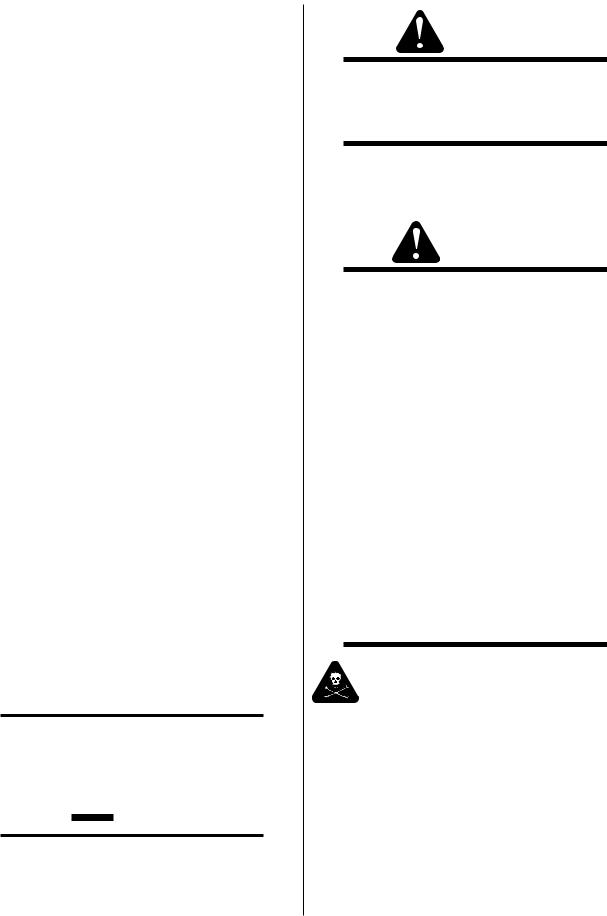
8.NFPA Standard 51, OXYGEN-FUEL GAS SYSTEMS FOR WELDING, CUTTING AND ALLIED PROCESSES, obtainable from the National Fire Protection Association, Batterymarch Park, Quincy, MA 02269
9.NFPAStandard 70, NATIONAL ELECTRICAL CODE, obtainable from the National Fire Protection Association, Batterymarch Park, Quincy, MA 02269
10.NFPA Standard 51B, CUTTING AND WELDING PROCESSES, obtainable from the National Fire Protection Association, Batterymarch Park, Quincy, MA 02269
11.CGA Pamphlet P-1, SAFE HANDLING OF COMPRESSED GASES IN CYLINDERS, obtainable from the Compressed Gas Association, 1235 Jefferson Davis Highway, Suite 501, Arlington, VA 22202
12.CSA Standard W117.2, CODE FOR SAFETY IN WELDING AND CUTTING, obtainable from the Canadian Standards Association, Standards Sales, 178 Rexdale Boulevard, Rexdale, Ontario, Canada M9W 1R3
13.NWSA booklet, WELDING SAFETY BIBLIOGRAPHY obtainable from the National Welding Supply Association, 1900 Arch Street, Philadelphia, PA 19103
14.American Welding Society Standard AWSF4.1, RECOMMENDED SAFE PRACTICES FOR THE PREPARATION FOR WELDING AND CUTTING OF CONTAINERS AND PIPING THAT HAVE HELD HAZARDOUS SUBSTANCES, obtainable from the American Welding Society, 550 N.W. LeJeune Rd, Miami, FL 33126
15.ANSI Standard Z88.2, PRACTICE FOR RESPIRATORY PROTECTION, obtainable from American National Standards Institute, 1430 Broadway, New York, NY 10018
1.04Note, Attention et Avertissement
Dans ce manuel, les mots “note,” “attention,” et “avertissement” sont utilisés pour mettre en relief des informations à caractère important. Ces mises en relief sont classifiées comme suit :
NOTE
Toute opération, procédure ou renseignement général sur lequel il importe d’insister davantage ou qui contribue à l’efficacité de fonctionnement du système.
ATTENTION
Toute procédure pouvant résulter l’endommagement du matériel en cas de nonrespect de la procédure en question.
AVERTISSEMENT
Toute procédure pouvant provoquer des blessures de l’opérateur ou des autres personnes se trouvant dans la zone de travail en cas de non-respect de la procédure en question.
1.05 Precautions De Securite
Importantes
AVERTISSEMENTS
L’OPÉRATION ET LA MAINTENANCE DU MATÉRIEL DE SOUDAGE À L’ARC AU JET DE PLASMA PEUVENT PRÉSENTER DES RISQUES ET DES DANGERS DE SANTÉ.
Coupant à l’arc au jet de plasma produit de l’énergie électrique haute tension et des émissions magnétique qui peuvent interférer la fonction propre d’un “pacemaker” cardiaque, les appareils auditif, ou autre matériel de santé electronique. Ceux qui travail près d’une application à l’arc au jet de plasma devrait consulter leur membre professionel de médication et le manufacturier de matériel de santé pour déterminer s’il existe des risques de santé.
Il faut communiquer aux opérateurs et au personnel TOUS les dangers possibles. Afin d’éviter les blessures possibles, lisez, comprenez et suivez tous les avertissements, toutes les précautions de sécurité et toutes les consignes avant d’utiliser le matériel. Composez le + 603-298-5711 ou votre distributeur local si vous avez des questions.
FUMÉE et GAZ
La fumée et les gaz produits par le procédé de jet de plasma peuvent présenter des risques et des dangers de santé.
•Eloignez toute fumée et gaz de votre zone de respiration. Gardez votre tête hors de la plume de fumée provenant du chalumeau.
•Utilisez un appareil respiratoire à alimentation en air si l’aération fournie ne permet pas d’éliminer la fumée et les gaz.
Date: 6/22/99 |
3 |
GENERAL INFORMATION |
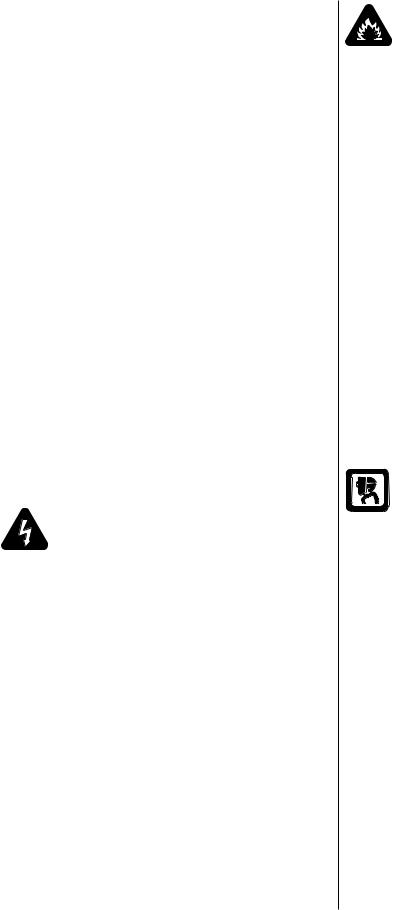
•Les sortes de gaz et de fumée provenant de l’arc de plasma dépendent du genre de métal utilisé, des revêtements se trouvant sur le métal et des différents procédés. Vous devez prendre soin lorsque vous coupez ou soudez tout métal pouvant contenir un ou plusieurs des éléments suivants:
antimoine |
cadmium |
mercure |
argent |
chrome |
nickel |
arsenic |
cobalt |
plomb |
baryum |
cuivre |
sélénium |
béryllium |
manganèse |
vanadium |
•Lisez toujours les fiches de données sur la sécurité des matières (sigle américain “MSDS”); celles-ci devraient être fournies avec le matériel que vous utilisez. Les MSDS contiennent des renseignements quant à la quantité et la nature de la fumée et des gaz pouvant poser des dangers de santé.
•Pour des informations sur la manière de tester la fumée et les gaz de votre lieu de travail, consultez l’article 1 et les documents cités à la page 5.
•Utilisez un équipement spécial tel que des tables de coupe à débit d’eau ou à courant descendant pour capter la fumée et les gaz.
•N’utilisez pas le chalumeau au jet de plasma dans une zone où se trouvent des matières ou des gaz combustibles ou explosifs.
•Le phosgène, un gaz toxique, est généré par la fumée provenant des solvants et des produits de nettoyage chlorés. Eliminez toute source de telle fumée.
CHOC ELECTRIQUE
Les chocs électriques peuvent blesser ou même tuer. Le procédé au jet de plasma requiert et produit de l’énergie électrique haute tension. Cette énergie électrique peut produire des chocs graves, voire mortels, pour l’opérateur et les autres personnes sur le lieu de travail.
•Ne touchez jamais une pièce “sous tension” ou “vive”; portez des gants et des vêtements secs. Isolez-vous de la pièce de travail ou des autres parties du circuit de soudage.
•Réparez ou remplacez toute pièce usée ou endommagée.
•Prenez des soins particuliers lorsque la zone de travail est humide ou moite.
•Montez et maintenez le matériel conformément au Code électrique national des Etats-Unis. (Voir la page 5, article 9.)
•Débranchez l’alimentation électrique avant tout travail d’entretien ou de réparation.
•Lisez et respectez toutes les consignes du Manuel de consignes.
INCENDIE ET EXPLOSION
Les incendies et les explosions peuvent résulter des scories chaudes, des étincelles ou de l’arc de plasma. Le procédé à l’arc de plasma produit du métal, des étincelles, des scories chaudes pouvant mettre le feu aux matières combustibles ou provoquer l’explosion de fumées inflammables.
•Soyez certain qu’aucune matière combustible ou inflammable ne se trouve sur le lieu de travail. Protégez toute telle matière qu’il est impossible de retirer de la zone de travail.
•Procurez une bonne aération de toutes les fumées inflammables ou explosives.
•Ne coupez pas et ne soudez pas les conteneurs ayant pu renfermer des matières combustibles.
•Prévoyez une veille d’incendie lors de tout travail dans une zone présentant des dangers d’incendie.
•Le gas hydrogène peut se former ou s’accumuler sous les pièces de travail en aluminium lorsqu’elles sont coupées sous l’eau ou sur une table d’eau. NE PAS couper les alliages en aluminium sous l’eau ou sur une table d’eau à moins que le gas hydrogène peut s’échapper ou se dissiper. Le gas hydrogène accumulé explosera si enflammé.
RAYONS D’ARC DE PLASMA
Les rayons provenant de l’arc de plasma peuvent blesser vos yeux et brûler votre peau. Le procédé à l’arc de plasma produit une lumière infra-rouge et des rayons ultra-vio- lets très forts. Ces rayons d’arc nuiront à vos yeux et brûleront votre peau si vous ne vous protégez pas correctement.
•Pour protéger vos yeux, portez toujours un casque ou un écran de soudeur. Portez toujours des lunettes de sécurité munies de parois latérales ou des lunettes de protection ou une autre sorte de protection oculaire.
•Portez des gants de soudeur et un vêtement protecteur approprié pour protéger votre peau contre les étincelles et les rayons de l’arc.
•Maintenez votre casque et vos lunettes de protection en bon état. Remplacez toute lentille sale ou comportant fissure ou rognure.
•Protégez les autres personnes se trouvant sur la zone de travail contre les rayons de l’arc en fournissant des cabines ou des écrans de protection.
GENERAL INFORMATION |
4 |
Date 6/22/99 |

•Utilisez la nuance de lentille qui est suggèrée dans le recommendation qui suivent ANSI/ASC Z49.1:
|
Nuance Minimum |
Nuance Suggerée |
|
Courant Arc |
Protective Numéro |
Numéro |
|
Moins de 300* |
8 |
9 |
|
300 - 400* |
9 |
12 |
|
400 - 800* |
10 |
14 |
|
* Ces valeurs s’appliquent ou l’arc actuel est observé clairement. L’experience a démontrer que les filtres moins foncés peuvent être utilisés quand l’arc est caché par moiceau de travail.
 BRUIT
BRUIT
Le bruit peut provoquer une perte permanente de l’ouïe. Les procédés de soudage à l’arc de plasma peuvent provoquer des niveaux sonores supérieurs aux limites normalement acceptables. Vous dú4ez vous protéger les oreilles contre les bruits forts afin d’éviter une perte permanente de l’ouïe.
•Pour protéger votre ouïe contre les bruits forts, portez des tampons protecteurs et/ou des protections auriculaires. Protégez également les autres personnes se trouvant sur le lieu de travail.
•Il faut mesurer les niveaux sonores afin d’assurer que les décibels (le bruit) ne dépassent pas les niveaux sûrs.
•Pour des renseignements sur la manière de tester le bruit, consultez l’article 1, page 5.
1.06 Documents De Reference
Consultez les normes suivantes ou les révisions les plus récentes ayant été faites à celles-ci pour de plus amples renseignements :
1.OSHA, NORMES DE SÉCURITÉ DU TRAVAIL ET DE PROTECTION DE LA SANTÉ, 29CFR 1910, disponible auprès du Superintendent of Documents, U.S. Government Printing Office, Washington, D.C. 20402
2.Norme ANSI Z49.1, LA SÉCURITÉ DES OPÉRATIONS DE COUPE ET DE SOUDAGE, disponible auprès de la Société Américaine de Soudage (American Welding Society), 550 N.W. LeJeune Rd., Miami, FL 33126
3.NIOSH, LA SÉCURITÉ ET LA SANTÉ LORS DES OPÉRATIONS DE COUPE ET DE SOUDAGE À L’ARC ET AU GAZ, disponible auprès du Superintendent of Documents, U.S. Government Printing Office, Washington, D.C. 20402
4.Norme ANSI Z87.1, PRATIQUES SURES POUR LA PROTECTION DES YEUX ET DU VISAGE AU TRAVAIL ET DANS LES ECOLES, disponible de l’Institut Américain des Normes Nationales (American National Standards Institute), 1430 Broadway, New York, NY 10018
5.Norme ANSI Z41.1, NORMES POUR LES CHAUSSURES PROTECTRICES, disponible auprès de l’American National Standards Institute, 1430 Broadway, New York, NY 10018
6.Norme ANSI Z49.2, PRÉVENTION DES INCENDIES LORS DE L’EMPLOI DE PROCÉDÉS DE COUPE ET DE SOUDAGE, disponible auprès de l’American National Standards Institute, 1430 Broadway, New York, NY 10018
7.Norme A6.0 de l’Association Américaine du Soudage (AWS), LE SOUDAGE ET LA COUPE DE CONTENEURS AYANT RENFERMÉ DES PRODUITS COMBUSTIBLES, disponible auprès de la American Welding Society, 550 N.W. LeJeune Rd., Miami, FL 33126
8.Norme 51 de l’Association Américaine pour la Protection contre les Incendies (NFPA), LES SYSTEMES À GAZ AVEC ALIMENTATION EN OXYGENE POUR LE SOUDAGE, LA COUPE ET LES PROCÉDÉS ASSOCIÉS, disponible auprès de la National Fire Protection Association, Batterymarch Park, Quincy, MA 02269
9.Norme 70 de la NFPA, CODE ELECTRIQUE NATIONAL, disponible auprès de la National Fire Protection Association, Batterymarch Park, Quincy, MA 02269
10.Norme 51B de la NFPA, LES PROCÉDÉS DE COUPE ET DE SOUDAGE, disponible auprès de la National Fire Protection Association, Batterymarch Park, Quincy, MA 02269
11.Brochure GCA P-1, LA MANIPULATION SANS RISQUE DES GAZ COMPRIMÉS EN CYLINDRES, disponible auprès de l’Association des Gaz Comprimés (Compressed Gas Association), 1235 Jefferson Davis Highway, Suite 501, Arlington, VA 22202
12.Norme CSA W117.2, CODE DE SÉCURITÉ POUR LE SOUDAGE ET LA COUPE, disponible auprès de l’Association des Normes Canadiennes, Standards Sales, 178 Rexdale Boulevard, Rexdale, Ontario, Canada, M9W 1R3
13.ivret NWSA, BIBLIOGRAPHIE SUR LASÉCURITÉ DU SOUDAGE, disponible auprès de l’Association Nationale de Fournitures de Soudage (National Welding Supply Association), 1900 Arch Street, Philadelphia, PA 19103
Date: 6/22/99 |
5 |
GENERAL INFORMATION |

14.Norme AWSF4.1 de l’Association Américaine de Soudage, RECOMMANDATIONS DE PRATIQUES SURES POUR LA PRÉPARATION À LA COUPE ET AU SOUDAGE DE CONTENEURS ET TUYAUX AYANT RENFERMÉ DES PRODUITS DANGEREUX , disponible auprès de la American Welding Society, 550 N.W. LeJeune Rd., Miami, FL 33126
15.Norme ANSI Z88.2, PRATIQUES DE PROTECTION RESPIRATOIRE, disponible auprès de l’American National Standards Institute, 1430 Broadway, New York, NY 10018
GENERAL INFORMATION |
6 |
Date 6/22/99 |
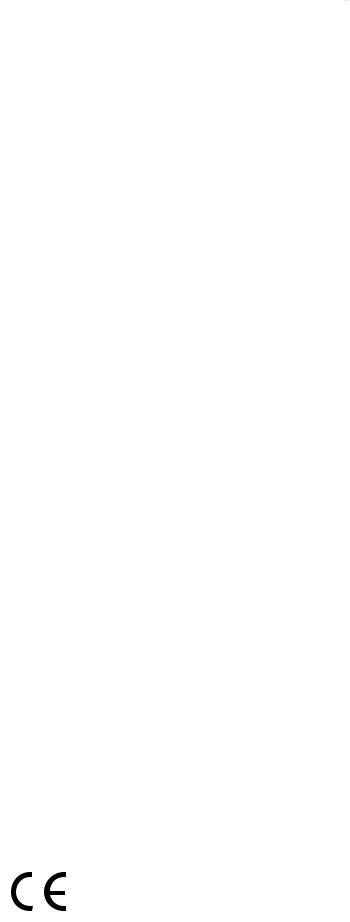
1.07 Declaration of Conformity
Manufacturer: Thermal Dynamics Corporation
Address: Industrial Park #2
West Lebanon, New Hampshire 03784
USA
The equipment described in this manual conforms to all applicable aspects and regulations of the ‘Low Voltage Directive’ (European Council Directive 73/23/EEC as amended by Council Directive 93/68/EEC) and to the National legislation for the enforcement of this Directive.
The equipment described in this manual conforms to all applicable aspects and regulations of the "EMC Directive" (European Council Directive 89/336/EEC) and to the National legislation for the enforcement of this Directive.
Serial numbers are unique with each individual piece of equipment and details description, parts used to manufacture a unit and date of manufacture.
National Standard and Technical Specifications
The product is designed and manufactured to a number of standards and technical requirements among them are:
*CSA (Canadian Standards Association) standard C22.2 number 60 for Arc welding equipment.
*UL (Underwriters Laboratory) rating 94VO flammability testing for all printed-circuit boards used.
*CENELEC EN50199 EMC Product Standard for Arc Welding Equipment.
*ISO/IEC 60974-1 (BS 638-PT10) (EN 60 974-1) (EN50192) (EN50078) applicable to plasma cutting equipment and associated accessories.
*Extensive product design verification is conducted at the manufacturing facility as part of the routine design and manufacturing process. This is to ensure the product is safe, when used according to instructions in this manual and related industry standards, and performs as specified. Rigorous testing is incorporated into the manufacturing process to ensure the manufactured product meets or exceeds all design specifications.
Thermal Dynamics has been manufacturing products for more than 30 years, and will continue to achieve excellence in our area of manufacture.
Manufacturers responsible representative: Steve Ward
Director of Operations
Thermadyne UK
Chorley England
Date: 6/22/99 |
7 |
GENERAL INFORMATION |

1.08 Statement of Warranty
LIMITED WARRANTY: Thermal Dynamics® Corporation (hereinafter “Thermal”) warrants that its products will be free of defects in workmanship or material. Should any failure to conform to this warranty appear within the time period applicable to the Thermal products as stated below, Thermal shall, upon notification thereof and substantiation that the product has been stored, installed, operated, and maintained in accordance with Thermal’s specifications, instructions, recommendations and recognized standard industry practice, and not subject to misuse, repair, neglect, alteration, or accident, correct such defects by suitable repair or replacement, at Thermal’s sole option, of any components or parts of the product determined by Thermal to be defective.
THIS WARRANTY IS EXCLUSIVE AND IS IN LIEU OF ANY WARRANTY OF MERCHANTABILITY OR FITNESS FOR A PARTICULAR PURPOSE.
LIMITATION OF LIABILITY: Thermal shall not under any circumstances be liable for special or consequential damages, such as, but not limited to, damage or loss of purchased or replacement goods, or claims of customers of distributor (hereinafter “Purchaser”) for service interruption. The remedies of the Purchaser set forth herein are exclusive and the liability of Thermal with respect to any contract, or anything done in connection therewith such as the performance or breach thereof, or from the manufacture, sale, delivery, resale, or use of any goods covered by or furnished by Thermal whether arising out of contract, negligence, strict tort, or under any warranty, or otherwise, shall not, except as expressly provided herein, exceed the price of the goods upon which such liability is based.
THIS WARRANTY BECOMES INVALID IF REPLACEMENT PARTS OR ACCESSORIES ARE USED WHICH MAY IMPAIR THE SAFETY OR PERFORMANCE OF ANY THERMAL PRODUCT.
THIS WARRANTY IS INVALID IF THE PRODUCT IS SOLD BY NON-AUTHORIZED PERSONS.
The limited warranty periods for Thermal products shall be as follows (with the exception of XL Plus Series, CutMaster 80XL , Cougar and DRAG-GUN): A maximum of three (3) years from date of sale to an authorized distributor and a maximum of two (2) years from date of sale by such distributor to the Purchaser, and with the further limitations on such two (2) year period (see chart below).
The limited warranty period for XL Plus Series and CutMaster 80XL shall be as follows: A maximum of four (4) years from date of sale to an authorized distributor and a maximum of three (3) years from date of sale by such distributor to the Purchaser, and with the further limitations on such three (3) year period (see chart below).
The limited warranty period for Cougar and DRAG-GUN shall be as follows: A maximum of two (2) years from date of sale to an authorized distributor and a maximum of one (1) year from date of sale by such distributor to the Purchaser, and with the further limitations on such two (2) year period (see chart below).
|
|
Parts |
|
|
|
|
|
XL Plus Series & |
Parts |
Parts |
|
||
PAK Units, Power Supplies |
|
CutMaster 80XL |
Cougar/Drag-Gun |
All Others |
Labor |
|
Main Power Magnetics |
|
3 Years |
|
1 Year |
2 Years |
1 Year |
Original Main Power Rectifier |
|
3 Years |
1 Year |
2 Years |
1 Year |
|
Control PC Board |
|
3 Years |
1 Year |
2 Years |
1 Year |
|
All Other Circuits And Components Including, |
|
1 Year |
1 Year |
1 Year |
1 Year |
|
But Not Limited To, Starting Circuit, |
|
|
|
|
|
|
Contactors, Relays, Solenoids, Pumps, |
|
|
|
|
|
|
Power Switching Semi-Conductors |
|
|
|
|
|
|
Consoles, Control Equipment, Heat |
|
1 Year |
|
1 Year |
1 Year |
|
Exchanges, And Accessory Equipment |
|
|
|
|
|
|
Torch And Leads |
|
|
|
|
|
|
Maximizer 300 Torch |
|
|
|
|
1 Year |
1 Year |
All Other Torches |
|
180 Days |
180 Days |
180 Days |
180 Days |
|
Repair/Replacement Parts |
|
90 Days |
90 Days |
90 Days |
None |
|
Warranty repairs or replacement claims under this limited warranty must be submitted by an authorized Thermal Dynamics® repair facility within thirty (30) days of the repair. No transportation costs of any kind will be paid under this warranty. Transportation charges to send products to an authorized warranty repair facility shall be the responsibility of the customer. All returned goods shall be at the customer’s risk and expense. This warranty supersedes all previous Thermal warranties.
Effective May 6, 1999
GENERAL INFORMATION |
8 |
Date 6/22/99 |
